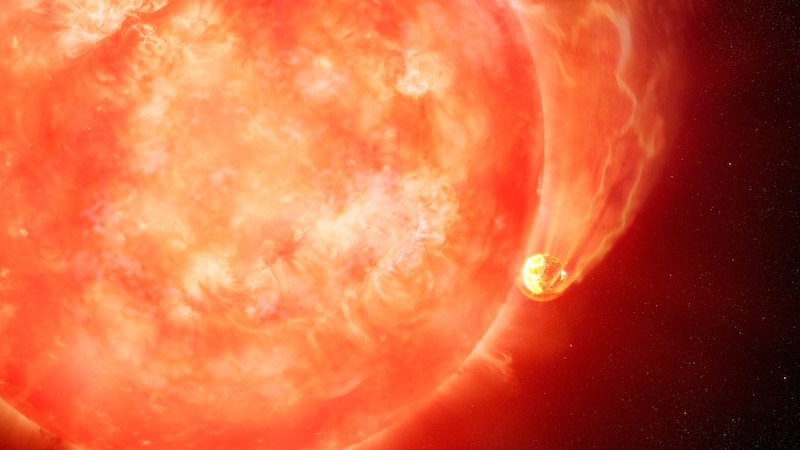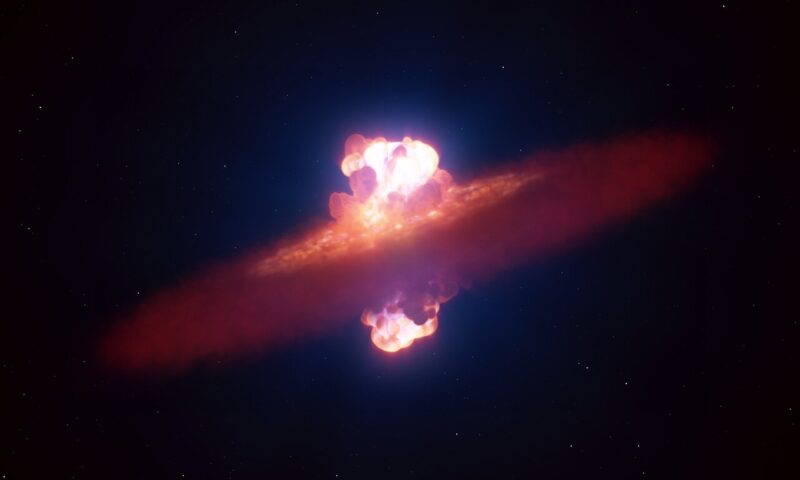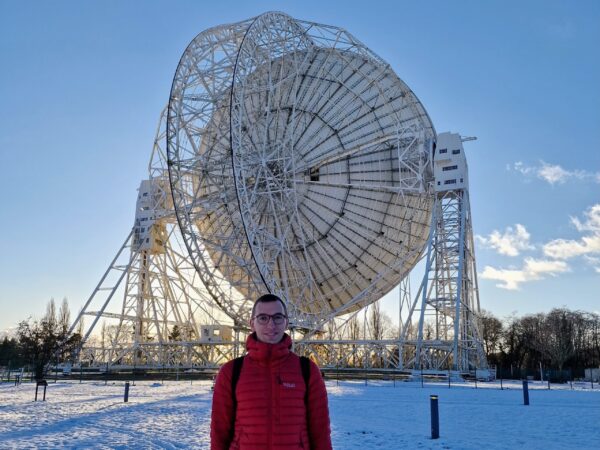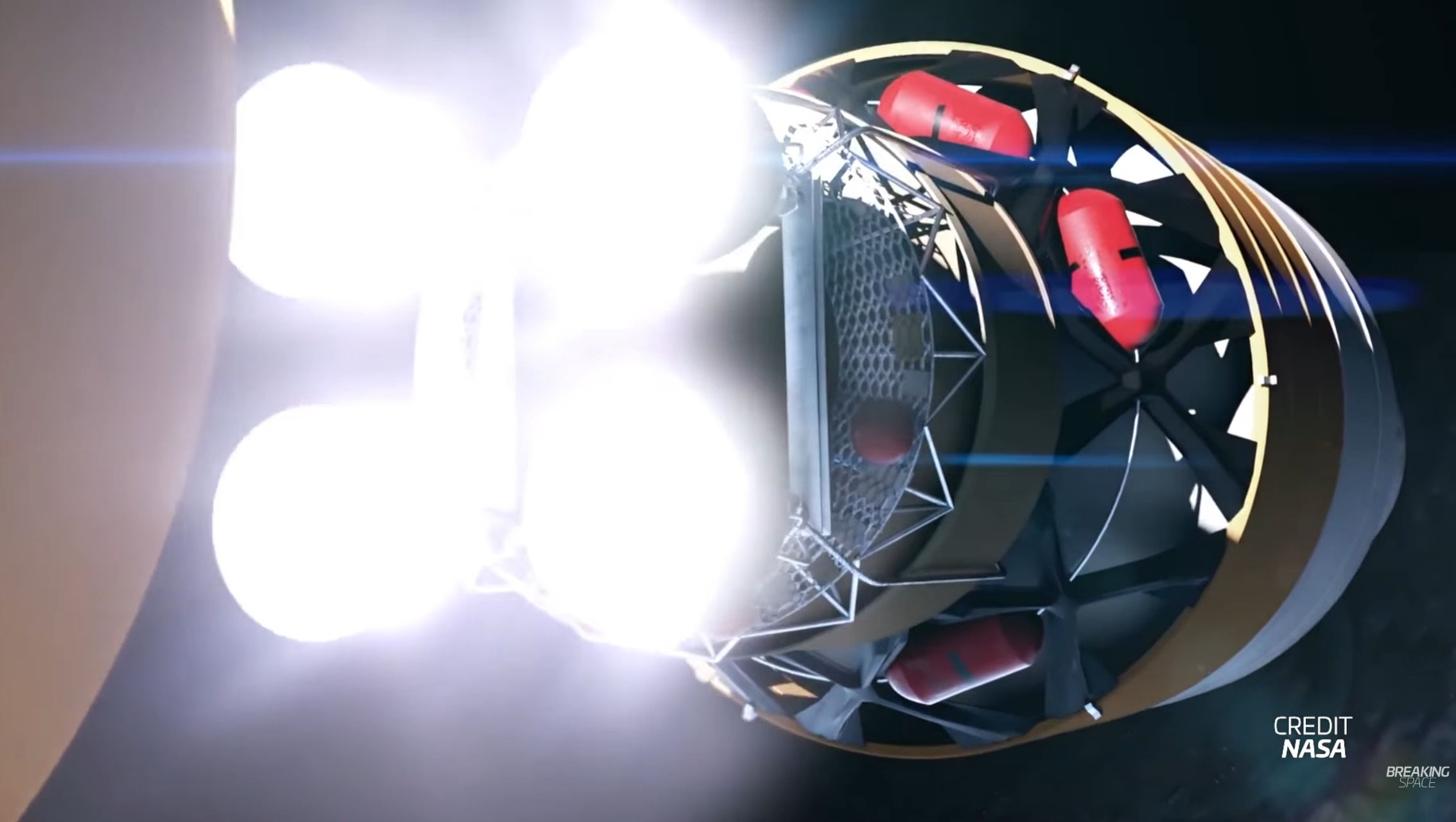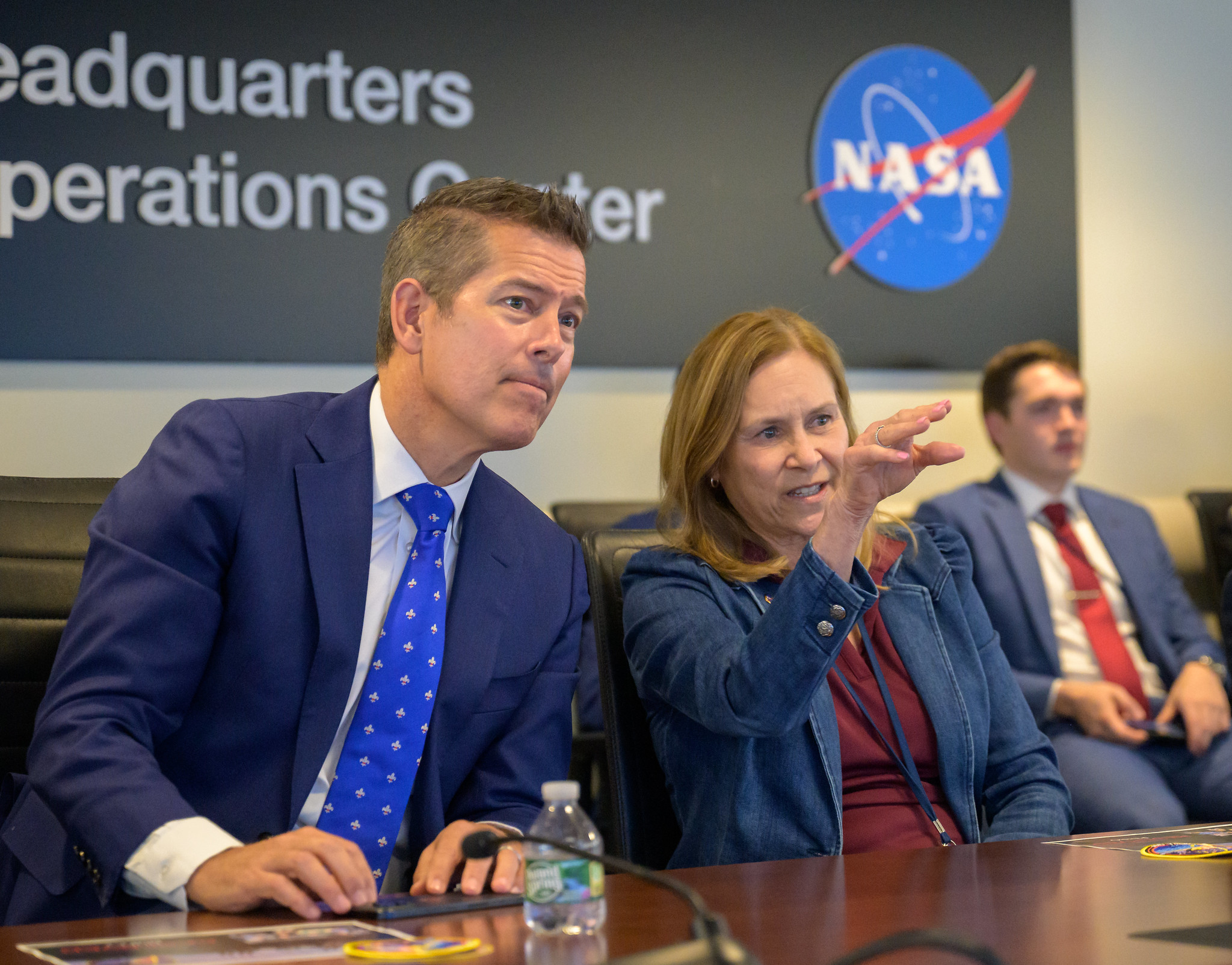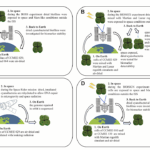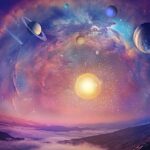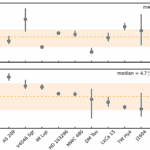Now Reading: Did Webb find a black hole formed by a direct collapse?
-
01
Did Webb find a black hole formed by a direct collapse?
Did Webb find a black hole formed by a direct collapse?
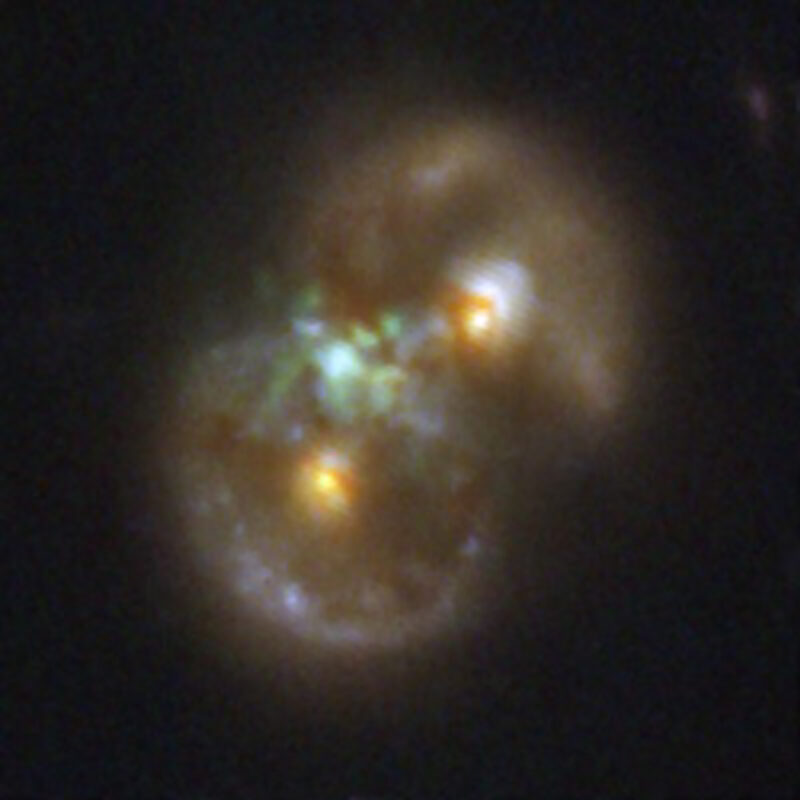
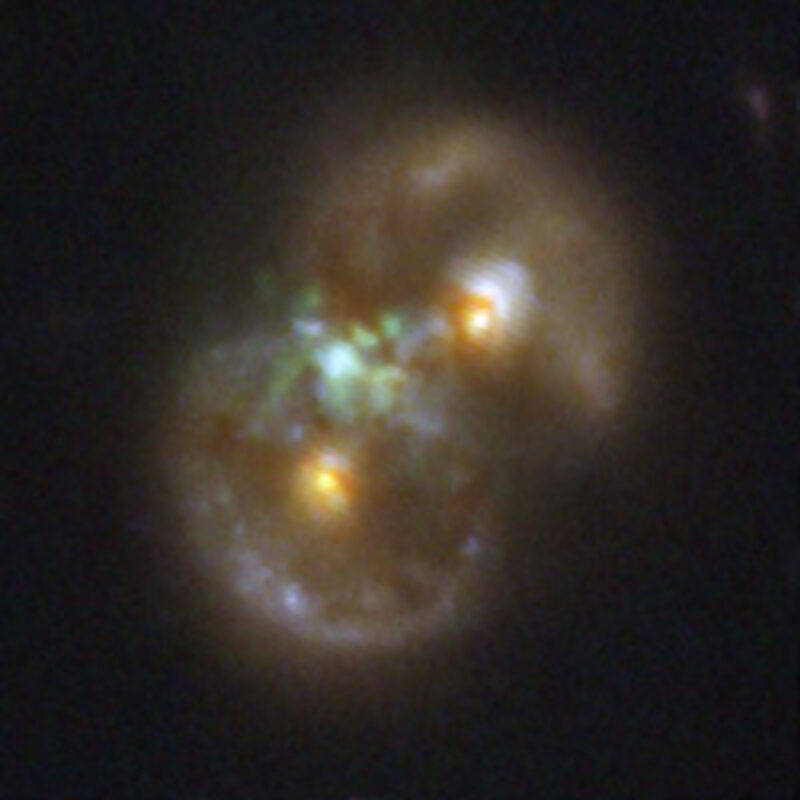
- The Infinity galaxy is a pair of interacting galaxies that have a shape like an infinity symbol. The Webb telescope captured the above image of this unique object.
- Astronomers discovered a black hole between the galaxies, in the greenish-blue area in the image. This area is a large swath of ionized gas.
- This black hole might be the result of direct collapse. It’s a theorized way to make a black hole by the direct collapse of a gas cloud.
NASA published this original post on July 15, 2025. Edits by EarthSky.
Did Webb find a black hole formed by a direct collapse?
As data from NASA’s James Webb Space Telescope becomes public, researchers hunt its archives for unnoticed cosmic oddities. With this in mind, while examining images from the COSMOS-Web survey, two researchers, Pieter van Dokkum of Yale University and Gabriel Brammer of the University of Copenhagen, discovered an unusual object that they nicknamed the Infinity galaxy.
It displays a highly unusual shape of two very compact, red nuclei, each surrounded by a ring, giving it the shape of the infinity symbol. The team believes it was formed by the head-on collision of two disk galaxies. In addition, follow-up observations showed that the Infinity galaxy hosts an active, supermassive black hole. What is highly unusual is that the black hole is in between the two nuclei, within a vast expanse of gas. So, the team proposes that the black hole formed there via the direct collapse of a gas cloud. Basically, this is a process that may explain some of the incredibly massive black holes Webb has found in the early universe.
The birth of a supermassive black hole
Here, Dokkum, lead author of a peer-reviewed paper describing their initial discovery and principal investigator of follow-up Webb observations, explains why this object could be the best evidence yet for a novel way of forming black holes.
Everything is unusual about this galaxy. Not only does it look very strange, but it also has this supermassive black hole that’s pulling a lot of material in. The biggest surprise of all was that the black hole was not located inside either of the two nuclei but in the middle. We asked ourselves: How can we make sense of this?
Finding a black hole that’s not in the nucleus of a massive galaxy is in itself unusual, but what’s even more unusual is the story of how it may have gotten there. It likely didn’t just arrive there, but instead it formed there. And pretty recently. In other words, we think we’re witnessing the birth of a supermassive black hole, something that has never been seen before.
Examining 2 seed theories
Dokkum continued:
How supermassive black holes formed is a long-standing question. There are two main theories, called ‘light seeds’ and ‘heavy seeds.’ In the light seed theory, you start with small black holes formed when a star’s core collapses and the star explodes as a supernova. That might result in a black hole weighing up to about 1,000 suns. You form a lot of them in a small space and they merge over time to become a much more massive black hole. The problem is, that merger process takes time. And Webb has found incredibly massive black holes at incredibly early times in the universe. Possibly even too early for this process to explain them.
The second possibility is the heavy seed theory, where a much larger black hole, maybe up to one million times the mass of our sun, forms directly from the collapse of a large gas cloud. You immediately form a giant black hole, so it’s much quicker. However, the problem with forming a black hole out of a gas cloud is that gas clouds like to form stars as they collapse rather than a black hole. So you have to find some way of preventing that. It’s not clear that this direct-collapse process could work in practice.
What the Infinity galaxy showed astronomers
Dokkum said:
By looking at the data from the Infinity galaxy, we think we’ve pieced together a story of how this could have happened here. Two disk galaxies collide, forming the ring structures of stars that we see. During the collision, the gas within these two galaxies shocks and compresses. This compression might just be enough to form a dense knot, which then collapsed into a black hole.
There is quite a bit of circumstantial evidence for this. We observe a large swath of ionized gas, specifically hydrogen that has been stripped of its electrons. That’s right in the middle between the two nuclei, surrounding the supermassive black hole. We also know that the black hole is actively growing. we see evidence of that in X-rays from NASA’s Chandra X-ray Observatory and radio from the Very Large Array. Nevertheless, the question is, did it form there?
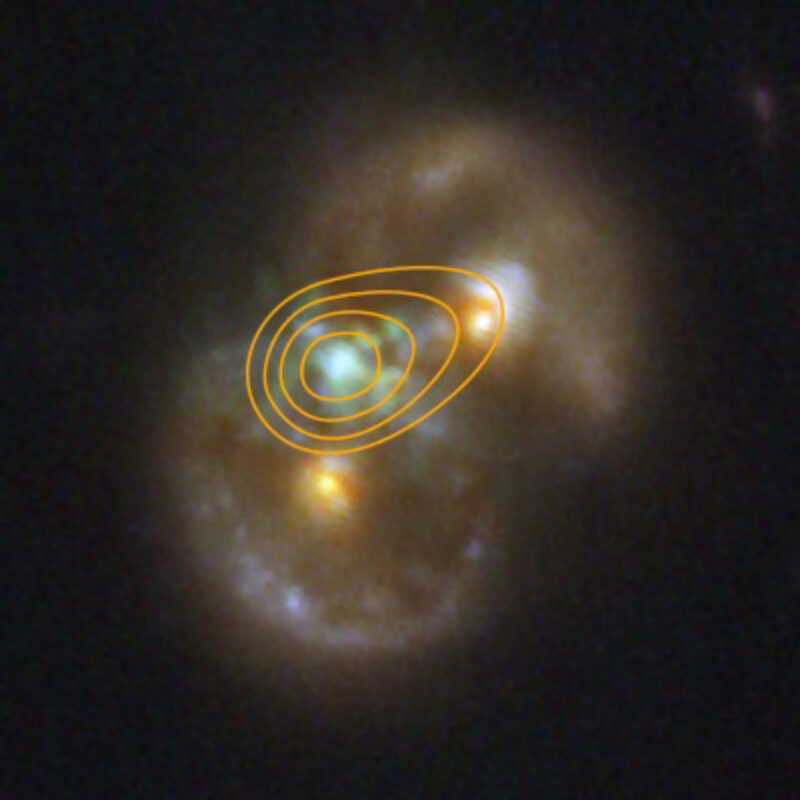
Other possibilities
Dokkum explained:
There are two other possibilities that come to mind. First, it could be a runaway black hole that got ejected from a galaxy and just happens to be passing through. Second, it could be a black hole at the center of a third galaxy in the same location on the sky. If it were in a third galaxy, we would expect to see the surrounding galaxy unless it were a faint dwarf galaxy. However, dwarf galaxies don’t tend to host giant black holes.
If the black hole were a runaway, or if it were in an unrelated galaxy, we would expect it to have a very different velocity from the gas in the Infinity galaxy. We realized that this would be our test: measure the velocity of the gas and the velocity of the black hole, and compare them. If the velocities are close, within maybe 30 miles per second (50 km per second), then it becomes hard to argue that the black hole is not formed out of that gas.
3 confirmed black holes
Finally, Dokkum described their results:
We applied for and received director’s discretionary time to follow up on this target with Webb, and our preliminary results are exciting. First, the presence of an extended distribution of ionized gas in between the two nuclei is confirmed. Second, the black hole is beautifully in the middle of the velocity distribution of this surrounding gas, as expected if it formed there. This is the key result that we were after!
Third, as an unexpected bonus, it turns out that both galaxy nuclei also have an active supermassive black hole. So, this system has three confirmed active black holes: two very massive ones in both of the galaxy nuclei, and the one in between them that might have formed there.
We can’t say definitively that we have found a direct collapse black hole. But we can say that these new data strengthen the case that we’re seeing a newborn black hole, while eliminating some of the competing explanations. We will continue to pore through the data and investigate these possibilities.
Bottom line: Astronomers used data from Webb to probe a black hole that might have formed from direct collapse between two interacting galaxies.
The post Did Webb find a black hole formed by a direct collapse? first appeared on EarthSky.
Stay Informed With the Latest & Most Important News
Previous Post
Next Post
-
 012024 in Review: Highlights from NASA in Silicon Valley
012024 in Review: Highlights from NASA in Silicon Valley -
 02Panasonic Leica Summilux DG 15mm f/1.7 ASPH review
02Panasonic Leica Summilux DG 15mm f/1.7 ASPH review -
 03How New NASA, India Earth Satellite NISAR Will See Earth
03How New NASA, India Earth Satellite NISAR Will See Earth -
 04And Thus Begins A New Year For Life On Earth
04And Thus Begins A New Year For Life On Earth -
 05Astronomy Activation Ambassadors: A New Era
05Astronomy Activation Ambassadors: A New Era -
06SpaceX launch surge helps set new global launch record in 2024
-
 07Space Force plans new ‘Futures Command’ amid pressure to speed up modernization
07Space Force plans new ‘Futures Command’ amid pressure to speed up modernization












